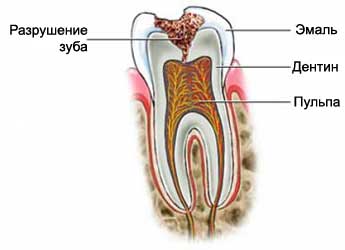Dental Crowns – Installing a dental crown
Description of the installation of dental crowns
Dental Crowns – cap, that covers the damaged tooth. Crown makes the tooth more resistant, and improves the appearance of the tooth.
Reasons for the installation of dental crowns
Tooth bit may be needed, If a tooth is damaged (eg, broken, zagnil, erased), or severely discolored. The crown is also set in the following cases:
- Supports tooth after filling, installing the dental implant or bridge;
- Protection of the tooth after root canal cleaning;
- Troubleshooting ževaniem.

Possible complications
Problems installing a dental Crown rare, but no procedure does not guarantee the absence of risk. The dentist will examine the risk of these potential problems:
- Allergic reactions to materials in the crown or local anesthesia;
- The need for additional procedures (if the crown is poorly installed);
- Damage to the nerve of the tooth (you may need a root canal cleaning);
- The expansion of the tooth under the crown (If bacteria enter the tooth);
- Tooth Sensitivity (especially in the use of hot or cold food);
- Dark lines on the gums, which sets the crown (If you are using a metal Crown).
How is the installation of a dental crown?
Preparation for the procedure
To install the crown usually requires two visits to the dentist. Prior to the installation of the crown, you and your dentist must decide, what type is best for you. Materials, which are used for the manufacture of permanent crowns, They include:
- Metals (eg, gold);
- Porcelain together metal – metallokeramika;
- Porcelain;
- Plastic;
- Ceramics.
You must also pass a dental check. The doctor will assess the state of health of the roots of teeth.
Consult your doctor about the drugs taken. A week before surgery you may be asked to stop taking some medicines:
- Aspirin and other nonsteroidal anti-inflammatory drugs (eg, Ibuprofen, naproxen);
- Blood-thinning drugs, such as warfarin;
- Antiplatelet drugs, such as clopidogrel.
Besides, tell the dentist about the presence of heart disease or disease of the joints. Maybe, you have to take antibiotics, to prevent infection.
Anesthesia
When installing a dental crown is used local anesthesia.
Description of the installation procedure of dental crowns
First visit
Dentist obezbolyt region, surrounding the tooth, typically administered a local anesthetic into the gum. Then, the dentist will prepare the tooth to install crown. The surface of the tooth to be treated – obpilena. If the tooth missing, dantist, perhaps, should add a special material to the tooth so, to the crown could be installed. This procedure is called build crowns.
The dentist makes a mold of the tooth, which is set to crown, and surrounding teeth, to make sure, The new crown will not affect the bite. Casts will be sent to the dental studio, where the crown will be made. If you plan to install porcelain crowns, the dentist will help you choose a shade, which is similar to the natural color of your teeth. Finally, the dentist will protect the tooth, the addition of a temporary crown. Through 2-3 Week permanent crown will be made and ready for installation.
Second visit
During his second visit to the dentist again numb the area setting crown. Temporary crown will be removed. It will use dental cement, to secure a new permanent crown in place.
How long will the installation of a dental crown?
You will need to apply two vizitav for several weeks. Each visit can last about 30-60minut.
Installing a dental crown – Will it hurt?
It may feel a burning sensation, when a local anesthetic is injected into the gum. After the procedure, there may be some discomfort or tooth sensitivity.
Care after installation of dental crowns
Care in a hospital
You will be able to return home immediately after the procedure.
Home Care
When you return home, Follow these steps::
- While installed temporary crown, special attention is paid to the following:
- Do not eat anything, which may cause the removal of the crown (eg, chewing gum or solid food);
- Chew the side of the mouth, which have crowns;
- It is necessary to carefully brush your teeth with dental floss, not to pull out the crown;
- If recommended by your dentist, you need to use toothpaste for sensitive teeth;
- Take care of dental health. Brush your teeth twice a day, and daily thread. Besides, you need to regularly clean the teeth of stone and visit the dentist for routine inspection;
- Avoid habits, which can damage teeth, eg, grind their teeth or bite off and eat cold ice cream;
- Be sure to follow the instructions of the dentist.
With proper care, a crown can serve for 5-15 years.
Contact your doctor after installation of dental crowns
After returning home, you need to turn to a dentist in the following cases:
- Temporary or permanent crown becomes damaged or falls;
- Do you suffer from pain or sensitivity around the new crown;
- There was an allergic reaction to the material of the crown.
